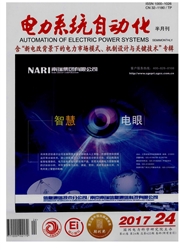

 中文摘要:
中文摘要:
低碳要素的引入将为传统的电力调度方法带来新问题和新挑战,在考虑安全性和经济性之外,还应进一步关注电力系统运行中的CO2排放。文中深入剖析了低碳电力调度的提出背景和内涵,定义了科学、高效的低碳电力调度方式;分析各类低碳电源的技术特性,建立了近零碳排放电源、普通化石燃料类电源和碳捕集电厂3类不同电源的电碳调度特性;将CO2排放作为一类可调度资源,在综合考虑低碳电力技术、碳成本和碳约束等要素的基础上,建立了低碳电力调度决策的初步模型,以协调电力调度中的"电平衡"与"碳平衡"。基于实际算例,分析了各类低碳要素的引入对于最优发电计划决策的影响。
 英文摘要:
英文摘要:
The introduction of various low-carbon factors will impose significant constraints on traditional power dispatch. In a carbon-constrained world, apart from security and economy, which are the most important targets in traditional power dispatch mechanisms, more attention should be paid to the reduction of CO2 emission in power system operation. A new mechanism is proposed for lower-carbon power dispatch that takes a comprehensive consideration of security, economy and CO2 emission reduction. The background and definition of lower-carbon power dispatch mechanism are analyzed and the characteristics of lower-carbon power sources are defined. The relations between power generation and CO2 emission of various power plants are formulated and divided into three categories, the near-zero emission power sources, normal fossil fuel-based power plants, and carbon capture power plants. On this basis, a preliminary model is presented to formulate a lower-carbon power dispatch mechanism that takes into account the low-carbon power techniques, cost and emission constraints. The impact of the introduction of various low-carbon factors on the optimum power generation schedule is analyzed with examples.
 同期刊论文项目
同期刊论文项目
 同项目期刊论文
同项目期刊论文
 期刊信息
期刊信息
